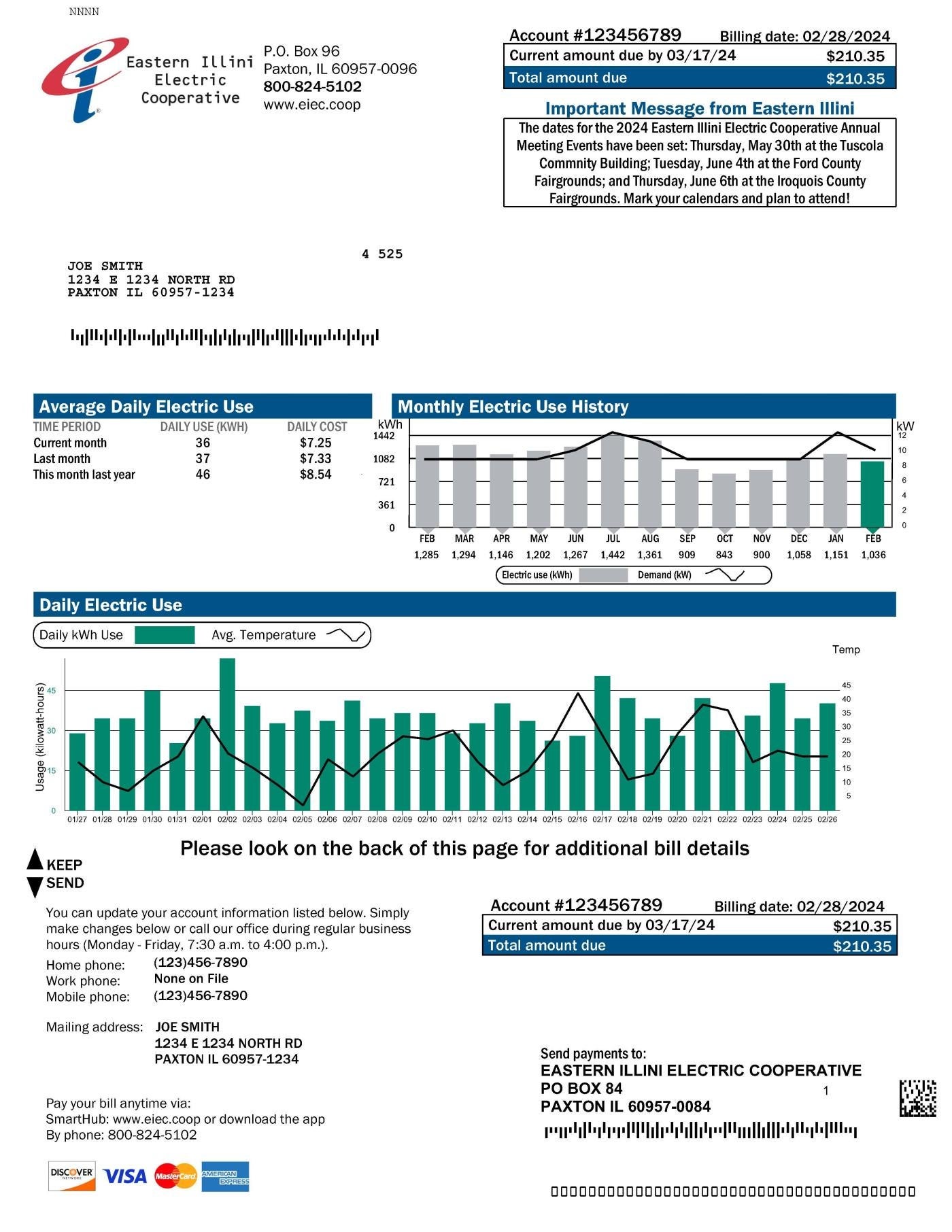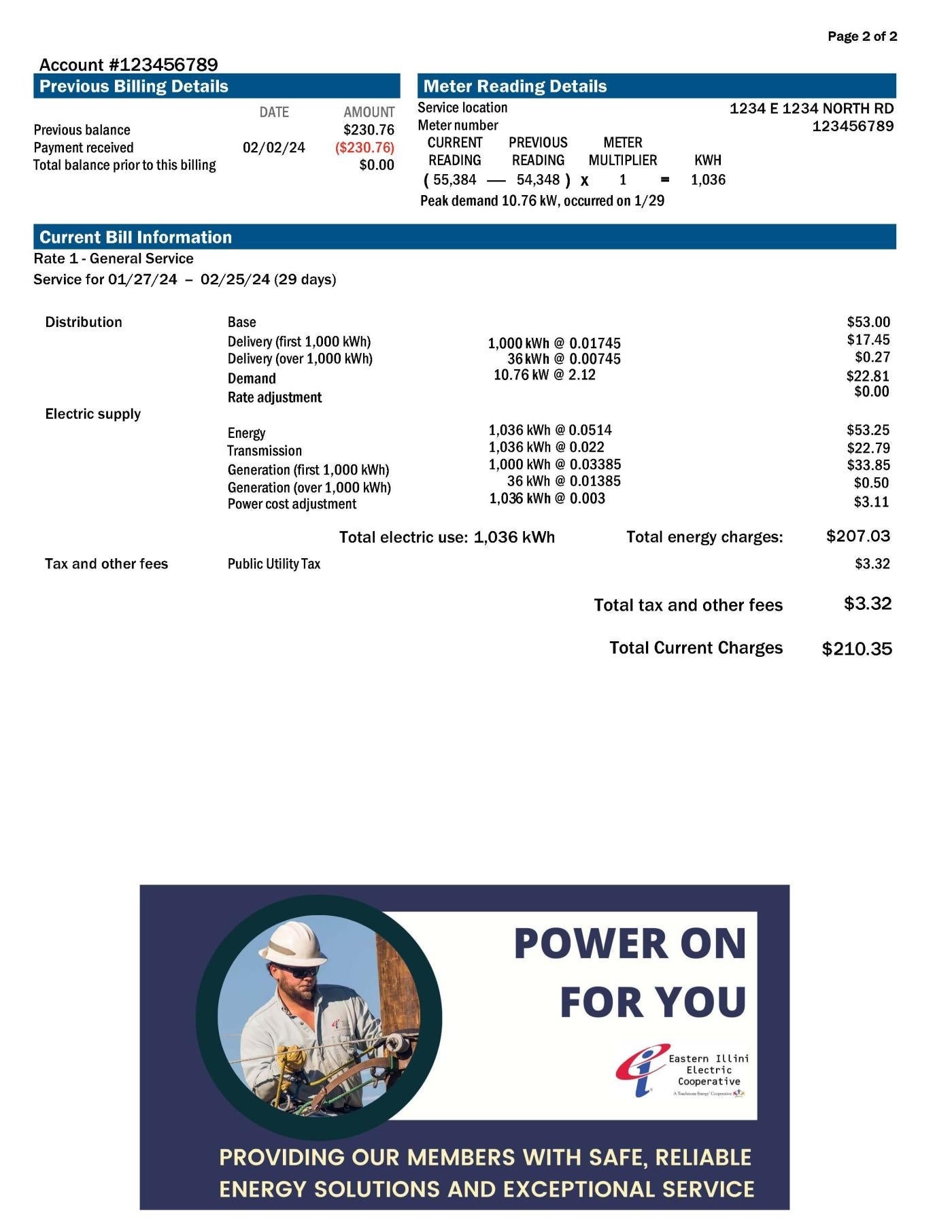Your monthly electric bill is designed to easily get you the information you need, and also be transparent about how your electric dollar is spent. The following explanations are designed to be read with a copy of your bill in hand, or you can utilize the sample images on this page.
Understanding Your Bill
Front Page
We start with your bill amount in the upper right hand corner. If that is your only focus, you're good to go!
Next is an informational message to let you know what is going on at Eastern Illini.
We then list three charts and graphs so you can get a better understanding of how you're using your electricity, and how it compares to previous months. The average daily electric use section shows both your daily electric (kWh) use and your average daily cost. The monthly electric use history section shows how your current month's electric use and demand compare to the previous 12 months. They daily electric use graph then shows how much electricity you used each day, and also shows the average temperature so you can track how much weather impacts your electric use. TIP - it's has a big impact!
At the bottom of the front page, is your payment stub. if you pay via paper check, you'll want to include that pay stub in with your payment. The left side of that page lists the contact information we have for you. Please make sure that is correct - and update it if necessary.
Many members enjoy the convenience of using SmartHub to pay their bill each month. With SmartHub, you can view and pay bill, report outages, and track your electric use with even more graphs. All by using your smart phone or computer. Members using SmartHub can also decide whether or not they want to continue receiving paper bills.

Back Page
This is where we get into the details of how your bill amount was calculated.
In the upper left corner are the previous billing details section shows your previous balance, and when we received your most recent payment.
In the upper right are the meter reading details section that shows your service location and your actual meter reading details. To calculate your electric kWh use for the month, we subtract the previous meter reading from the current one, then multiplier that number by your "meter multiplier." Most members have a meter multiplier of 1, but some of our accounts that use a lot of electricity each month have multipliers higher than 1. At the bottom of this section is your peak demand, measured in kW, as well as the date on which the peak demand occurred.
The current bill information lists all of the components of your bill.
The distribution section recovers the fixed costs we incur in providing you access to the electric system. These costs include: facilities; poles; wires; transformers; substations; vehicles; service personnel; equipment maintenance; and other equipment that helps us maintain a safe and reliable distribution system. Also included are operating margins, metering, accounting, billing, member services and administrative personnel.
The base amount is a set monthly charge, similar to a monthly access fee you might pay for your phone service. It represents some of the fixed costs that we incur, even if you don’t use any electricity.
The delivery component covers the distribution costs related to moving electricity from our substations to your location.
The demand component is the maximum amount of power that is being consumed at a given time. It is related to, but different than, kWh, the amount of power used over a period of time. Your demand charge is based upon the maximum amount of power used over a 15-minute interval in a current billing period.
The rate adjustment is a placeholder that will eventually allow us to make small changes to our rates on an annual basis, if financial considerations from the previous year require it. If these small changes are required, they must be approved by our board of directors and they will remain in place for the entire year.
The energy portion recovers the actual cost of the electricity that you use. We receive electricity from our wholesale power provider, Prairie Power, Inc. (PPI). PPI is made up of ten Illinois electric cooperatives (including EIEC) that banded together to increase our collective buying power.
The transmission portion of your bill consists of the costs we pay to get electricity from power plants over high-voltage electric lines to the 25 substations on our distribution system. It is charged by the owners of the transmission lines.
The generation investment is based on your kWh use and represents our long-term investment (through PPI) in the Prairie State Energy Campus and other smaller power plants. This investment has enabled us to secure 30 years of stable energy pricing and will help shield us from potential increases in the cost to produce electricity.
The power cost adjustment (PCA) is the difference between the actual cost of the electricity we get from PPI and our projected costs. The PCA varies each month, and could be a negative amount, which would give you a bill credit.
The public utility tax is administered by the State of Illinois and applies to each kWh of electricity that you use.
The last section could include your outdoor light rental, service upgrades, deposits, adjustments, equipment loans and other miscellaneous charges.
At the bottom of back page is a marketing message, so we can keep you informed about important events.
If you have any additional questions, you can ask them on the EIEC Help Desk or by calling our toll free number at 800-824-5102.

